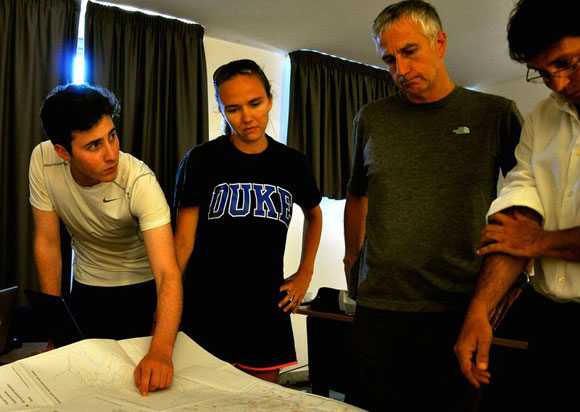
From drones to ancient tombs, students in the inaugural Duke in Tuscany program have learned how to blend emerging technology with the study of ancient cultures.
Read MoreBesides being the first Duke program in Tuscany, the team is also the first from a university outside Italy to conduct research in Vulci, an ancient Etruscan city and archaeological site north of Rome. Previously the local government was opposed to allowing outside universities into the archaeological park, but recent political changes and newly developed technologies allowed Maurizio Forte, William and Sue Gross Professor of classical studies at Duke, to implement the program.
"The local authorities didn't really know much about other possible areas that could be discovered," said Sonia Silvestri, research scientist at the Nicholas School of Environment who is part of the Tuscany program. "So I really think there is a real possibility to make a difference if more students and more programs are developed in the area."
The eight students enrolled in the program spent one week in lectures and three weeks in the field.
"Many global education programs are very focused on general training, but not fieldwork," Forte said. "Being in the field is like five years of [classroom] teaching or more."
There are still several areas of Vulci that have not yet been discovered, Silvestri said. The currently excavated areas include the centers of Vulci, which were transformed by ancient Romans when they conquered the Etruscans, and the necropolis.
Archaeologists are still trying to locate the exact position of the majority of the ancient city.
"Vulci is a very important archeological site," Forte said. "It's one of the most intact landscapes you can investigate in Italy."
During their first day in the field, students were able to explore an approximately 2,500-year-old Etruscan tomb. The tomb, recently discovered by local archaeologists, is the first intact tomb found in Vulci in at least two decades, Forte said.
"We went from making photo scans of the gargoyle statuettes outside to suddenly doing that for a 6th century B.C. tomb," junior art history major Justin Sandulli said. "It was almost like this transcendental moment where [Forte] handed me the camera and asked if I wanted to do the photo scanning. I ended up going three more times to do more models."
The students used GPS systems, high-resolution cameras and laser scanners to make 3-D models of the tomb and other sites throughout Vulci. Beyond mapping tombs, students also learned how to use drones to locate structures that are hidden underground. They will use the data they collected to plan future excavation projects.
Silvestri taught the students to utilize the drones in two ways. One is using an infrared digital camera to study the vegetation that develops in certain areas, looking at differences in soil moisture. Areas that cover ancient structures have distinctly different measures in soil moisture, and the vegetation on top grows with different characteristics. The second method uses high-resolution digital cameras to take photos of the surface and create 3-D renderings of the topography.
"The program has been really extraordinary in terms of that immersive educational quality," Sandulli said. "We will all come away with the knowledge that we were part of something extraordinary as far as the actual excavation is concerned, but also in terms of being able to have an experience as involved and mind -blowing as ours."
Forte said local government officials have promised their financial support for Duke students to continue the project in future summers.
"Many stakeholders are looking for new solutions and new ways to rethink the [archaeological] park in order to attract more tourists or at least to explain the complexity of the site in a different way," Forte said. "Very soon Duke University could have something more established and ambitious."
Pictured top: With Professor Maurizio Forte and ancient topography expert Giorgio Pocobelli, students review and interpret Pocobelli's mapped findings. Photo by Justin Sandulli